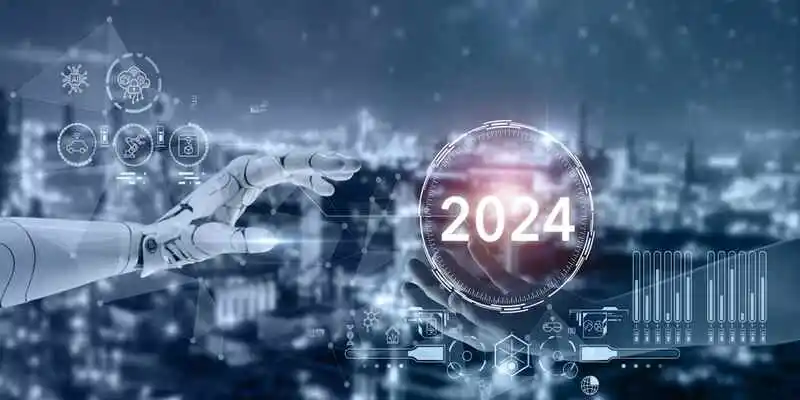Top AI Trends to Watch in 2024
AI is reshaping our behavior, making it integral to daily tasks. It revolutionizes industries with technologies like generative AI, multimodal AI, shadow AI, AI in sciences, and small language models. Let's explore the top AI trends in 2024 for a better understanding of their impact on our world.

While 2022 was the year of generative AI’s theatrical breakout, 2023 has been the Year of generative AI’s corporate entrenchment. 2024, therefore propounds itself for being the crucial year to determine how this evolution in the technological realm of intelligence would be beneficially incorporated into our lives.
Generative AI has emerged from computer scientists’ research phase and has already entered their ‘play’ or hobbyist period—and as with computers, progression means improved capability in less space. Starting with Meta launching its Lineage of LLMs, where LlaMa is one of the favored ones, the year 2023 saw the rise of foundation models becoming more efficient with open license, with other competitors such as StableLM, Falcon, Mistral, and Llama 2. As of today, DeepFloyd and Stable Diffusion are at nearly the same level of performance as the leading commercial models.
Statistics of Emerging Technologies in AI
The widespread use of new AI technology has an influence on all spheres of human endeavor. We deal with these sectors on a daily basis: healthcare, education, finance, retail, and many more. AI's primary duties in the fields of healthcare and life sciences include improving the precision of diagnoses, enabling customized therapy, assisting with drug discovery, and supporting several other vital processes. Algorithms driven by AI are used by the banking sector to improve risk assessment, identify fraud more successfully, and improve customer service. Supply chain optimization, customized marketing tactics, and demand forecasting are all made possible by emerging AI technology used by retail and e-commerce. Overall, let us present you with some additional statistical data that will help you better understand the trends in the growth of the AI business.
According to MarketsandMarkets research, the worldwide artificial intelligence market is expected to grow at a compound annual growth rate (CAGR) of 36.8% from 2023 to 2030, when it reaches USD 1345.2 billion. Its synergistic connection with several other technologies is the reason behind its fast rise. Artificial intelligence's capabilities and its application are expanded by its convergence with other disruptive technologies like robotics, computer vision, natural language processing (NLP), and the Internet of Things (IoT). Below, we will go over each of these technologies.
The Statista research states that in 2022, about 92 billion US dollars were invested globally by corporations in artificial intelligence, a little decline from the year before. Since 2016, investments in AI have grown by more than six times, which is an incredible boom in any business. It is evidence of the significance of the global advancement of new AI technology. Furthermore, according to the 2022 Gartner poll, 80% of executives believe that automation can boost any kind of business decision. A third of companies are using AI across several business divisions.
Concerned about losing your work with AI advancements? Thankfully, the answer is no, you really shouldn't. The World Economic Forum makes sure that the employment market will be greatly impacted by the growth of AI. It is predicted that by 2030, artificial intelligence (AI) would generate 70 million new employment globally, while eliminating 20 million, leaving a net gain of 50 million jobs.
According to the June 2023 LinkedIn US Executive Confidence Index Survey, executives have a positive outlook: 47% think that generative AI would increase productivity, 44% want to increase their use of AI in the upcoming year, and 40% see AI as the secret to achieving growth and revenue. This opinion is further supported by Microsoft's 2023 Work Trend Index, which shows that about 70% of people happily assign work to AI to reduce their workloads.
AI, ML, and NLP in 2024: An Overview
Artificial intelligence (AI) is the imitation of human cognitive processes by computers. These processes include learning (acquiring knowledge and the rules for utilizing it), reasoning (applying rules/laws to obtain approximate or definite conclusions), and self-correction. Machine Learning (ML), a subset of AI, refers to using algorithms and statistical models that allow computers to accomplish tasks without explicit guidance, relying instead on patterns and inference.
The Current State of AI in Various Industries
As of 2024, artificial intelligence has acquired a strong foothold across numerous industries:
1. Healthcare: Artificial intelligence transformed diagnostics, customized treatment, clinical practices, and drug development. Machine learning algorithms assess medical imagery, anticipate disease outbreaks, and help design new medicines.
2. Finance: AI-driven advancements in finance, such as fraud detection, algorithmic trading, and customized banking, are improving efficiency and security.
3. Retail: AI improves retail experiences with tailored suggestions, inventory management, and predictive analytics.
4. Manufacturing: AI enhances manufacturing processes, predictive maintenance, and quality control, resulting in more efficiency and lower costs.
5. Entertainment: AI algorithms underpin recommendation systems on platforms like Netflix and Spotify, and AI-generated content is growing increasingly popular.
Current State of Natural Language Processing (NLP)
Natural Language Processing (NLP) has made significant advances with models like GPT-4, BERT, and T5. These models have considerably enhanced robots' capacity to perceive and create human language. It resulted in more natural and coherent interactions between people and machines.
- GPT-4: The successor to GPT-3, GPT-4 has increased model size and enhanced language creation, comprehension, and context understanding.
- BERT: Bidirectional Encoder Representations from Transformers (BERT) improves language comprehension, including question answering and sentiment analysis.
- T5: The Text-to-Text Transfer Transformer (T5) paradigm simplifies training and implementation by defining NLP tasks as a single text-to-text issue.
- GPT-4o: GPT-4o is an optimized variant of OpenAI's GPT-4, designed for enhanced performance and efficiency in natural language processing tasks.
- Gemini: Gemini is a Google DeepMind project that aims to advance AI capabilities. It focuses on general intelligence and incorporate cutting-edge research in machine learning and neural networks.
Top AI Trends to Watch in 2024
Here is a comprehensive overview of the current and emerging AI trends that are set to shape the landscape in 2024.
1. Generative AI: Beyond Pictures and Words
Generative AI has resulted in significant transformation across industries, particularly healthcare and creative industries.
Gen AI in healthcare aids with illness diagnosis and drug development by mimicking complicated biological systems, allowing for faster identification of prospective drug candidates. This technology improves content development in creative fields including digital art, music, and video production. It allows for personalized content that is tailored to user or customer tastes.
The capacity of generative AI to automate and improve creative processes results in considerable time and cost savings and new customization possibilities. It has led to a continued spike in consumer interest in the field. But as Gen AI becomes more and more commonplace, ethical questions are raised about authenticity, customization output accuracy, and the possibility of employment displacement in creative industries. Inappropriate use of technology, such as the creation of deepfake content, might have detrimental effects on society.
Generative AI has the potential to further transform marketing, customer interaction, and product design for businesses by facilitating the development of more creative and flexible user experiences. Businesses must exercise caution while utilizing generative AI, though. They must manage the moral dilemmas and any fallout from the improper application of AI technology. Plus, they must ensure that they employ generative AI to uphold consumer confidence and brand integrity.
2. Multi-model AI
Nevertheless, the goal of cutting-edge generative AI is rising. The next wave of developments will concentrate on multimodal models. These can accept numerous forms of data as input, rather than just improving performance in a particular area. While models that function across multiple data modalities are not a novel concept—for example, speech-to-text models like Wave2Vec and text-to-image models like CLIP have been available for years—they have usually only functioned in one direction and were designed to complete a particular goal.
The upcoming generation of interdisciplinary models can seamlessly switch between computer vision and natural language processing (NLP) tasks. These models include both open source and proprietary models, such as LLaVa, ADEPT, and Google's Gemini, and OpenAI's GPT-4V.
Video is also being included by new models. Lumiere, a text-to-video diffusion model that can also handle image-to-video activities and use pictures as style guides, was unveiled by Google in late January.
Here are some particular ways that these recent developments are advantageous:
- Financial Data: Multimodal AI assists evaluate and drawing insights from financial data such as stock market movements, investment patterns, and financial statements.
- Customer Profiles: Artificial intelligence (AI) can generate detailed customer profiles for more effective targeting and customization. It analyzes several customer-related data, including their interests, purchase patterns, and demographics.
- Marketing Insights: AI can produce insightful marketing data by analyzing multiple data sources. This includes determining target audiences, optimizing advertising campaigns, and assessing the efficacy of such ads.
Virtual assistants are also the main immediate advantages of multimodal AI. For instance, users may ask a question regarding a picture and get a response in natural language, or they can ask aloud for help repairing something and get step-by-step written instructions combined with visual assistance. Higher up, multimodal AI makes it possible for a model to handle a wider range of data inputs, extending and enriching the knowledge accessible for inference and training.
3. Shadow AI
As AI algorithms and machine learning models become more available, Shadow AI emerges as a top trend in 2024. This entails implementing AI tools and apps into enterprises without the permission or control of the IT department. This is especially problematic in businesses with a high risk of security breaches, data governance concerns, and compliance violations. According to The Conference Board's 2023 survey, more than half of US employees employ Gen AI technology at work, with one in ten using them daily.
Employees may be entering critical corporate data into unapproved AI technologies with minimal security, potentially exposing the data to breach. To balance the need for innovation with governance and security, organizations must establish clear guidelines and frameworks for AI deployment. This ensures that AI tools are used responsibly and support business objectives. These should also protect the organization's integrity and data, especially as shadow AI becomes more prevalent.
4. AI in Science
Experts predict significant advancements in AI technologies intended to accelerate scientific findings. The major focus is global issues including diseases, energy crises, and climate change. Microsoft researchers uses AI to create better weather forecasters, carbon estimators, and other tools for sustainable agriculture. This technology helps to slow down climate change and make farming more productive. Additionally, AI technologies are being developed to assist farmers in the field. One such technology is a chatbot that can use farm-specific data to assess the effectiveness of various irrigation techniques or assist a farmer in identifying a peculiar weed.
In the field of life sciences, scientists are working together to create the largest image-based AI model in the world to combat cancer. They also employ cutting-edge AI to discover novel compounds for ground-breaking medications and antibiotics.
Scientific research is undergoing a revolution driven by artificial intelligence. It also changes materials science, a discipline that develops novel materials with certain characteristics. A recent development demonstrated how artificial intelligence (AI) and high-performance computers might speed up the hunt for less hazardous battery materials.
5. Small Language Models
Smaller language models (SLMs) are gaining popularity because they can perform effectively like large language models (LLMs) while requiring fewer computational resources. Smaller than smartphones, SLMs are nonetheless capable of packing several billion parameters, which enables them to function well even on small devices. Since SLMs simply require a browser and don't require large financial commitments, their accessibility is fueling a boom of user-friendly AI applications.
In contrast to LLMs that rely on enormous internet datasets, this AI stands out as a major topic for 2024 and promises greater breakthroughs. The researchers push the bounds of performance using carefully chosen, high-quality training data.
Microsoft is embracing SLMs in the technology sector with models like Phi and Orca. These new concepts show that large models are not necessarily crucial to achieving high-performance AI, which may alter our future perspectives on the technology. The smaller models employ carefully selected, high-quality training data, in contrast to LLMs that are trained on massive volumes of internet data. Researchers have discovered new thresholds for both size and performance. We can anticipate better models this year that are intended to encourage more research and creativity.
Conclusion
By 2024, the quick progress AI is making will have a significant impact on many different sectors of the economy and our daily life. AI is transforming how we live, work, and engage with technology, ranging from healthcare and economics to education and creativity.
To fully utilize AI's promise and navigate its intricacies, consumers, researchers, students, and enthusiasts must remain up to date on these topics. A dedication to ethical AI development will be crucial as we investigate the potential of artificial intelligence further. It will aid in creating a future in which artificial intelligence advances society's well-being and works for the greater good.


